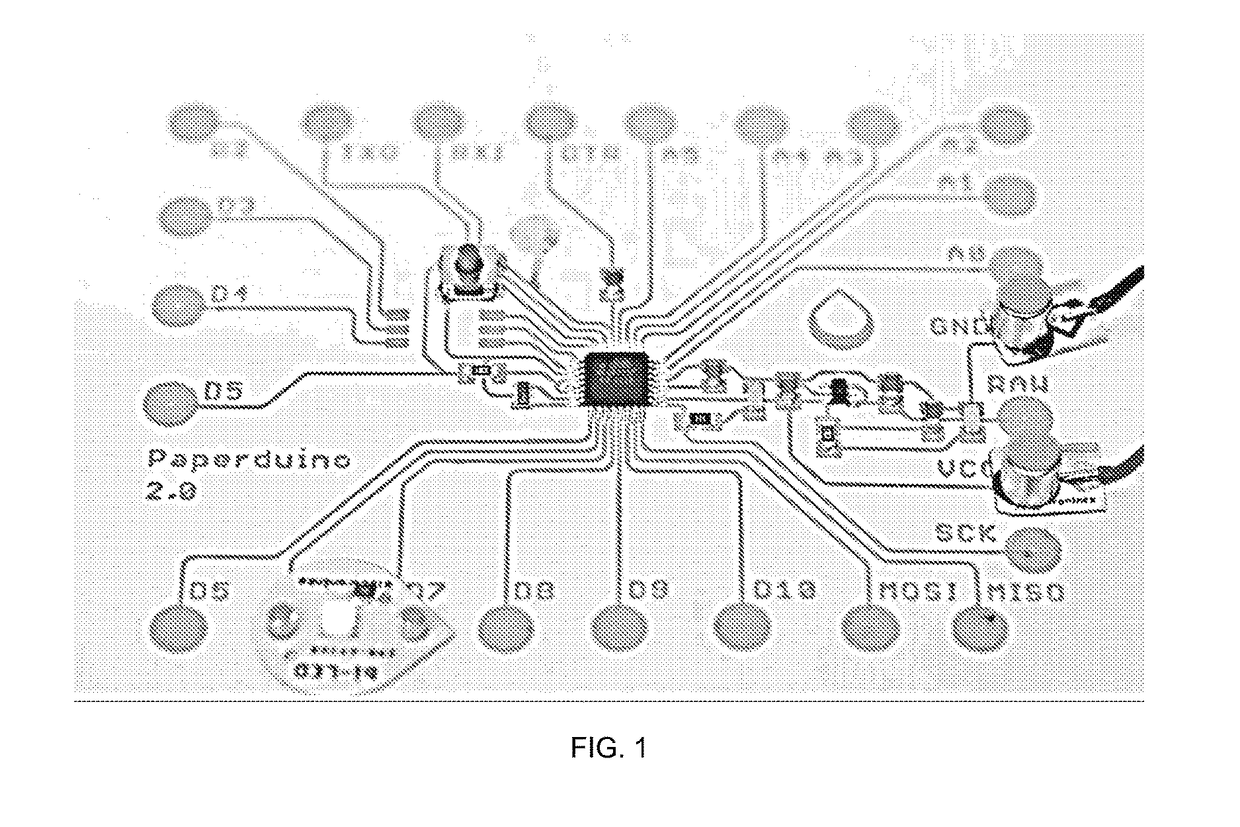Conductive ink for a rollerball pen and conductive trace formed on a substrate
a technology of conductive trace and rollerball pen, which is applied in the field of conductive trace formation, can solve the problems of costly deposition methods
- Summary
- Abstract
- Description
- Claims
- Application Information
AI Technical Summary
Benefits of technology
Problems solved by technology
Method used
Image
Examples
example 1
[0046]A conductive ink formulation is produced by dispersing 90% by weight silver flakes (average size 1-3 microns) and 10% by weight silver nanoparticles (average size 50-500 nm) using a poly(acrylic acid) dispersant at a loading level of 0.2 mg / m2. The nanoparticles are substantially spherical in morphology. The weight percentage of the silver in the solution (the solids loading) is adjusted to be 20 wt. % and the viscosity is increased by adding hydroxyethyl cellulose as a viscosifier at a concentration of 3% by weight of the silver. The conductive silver ink is thoroughly mixed and the final viscosity is determined to be 4000 cPs. The ink is deposited onto a substrate (paper) and dries rapidly at room temperature to form a silver trace. Upon drying, the resistivity of the silver trace is measured to be ≦10−4 Ohm-cm, which corresponds to a conductivity of about 1% of the bulk silver conductivity (Ag resistivity is 1.59×10−6 Ohm-cm) at room temperature, and the silver trace is obs...
example 2
[0047]A conductive ink formulation is produced by dispersing 90% by weight silver flakes (average size 1-3 microns) and 10% by weight silver nanoparticles (average size 50-500 nm) using a poly(acrylic acid) dispersant at a loading level of 0.2 mg / m2. The nanoparticles are substantially spherical in morphology. The weight percentage of the silver in the solution (the solids loading) is adjusted to be 50 wt. % and the viscosity is increased by adding hydroxyethyl cellulose as a viscosifier at a concentration of 3% by weight of the silver. The conductive silver ink is thoroughly mixed and the final viscosity is determined to be 4000 cPs. The ink is deposited onto a substrate and dries rapidly at room temperature to form a silver trace. Upon drying, the resistivity of the silver trace is measured to be ≦5×10−5 Ohm-cm, which corresponds to a conductivity of about 2% of the bulk silver conductivity at room temperature, and the silver trace is observed to have a metallic appearance.
example 3
[0048]A conductive ink formulation is produced by dispersing 90% by weight silver flakes (average size 1-3 microns) and 10% by weight silver nanoparticles (average size 50-500 nm) using a poly(acrylic acid) dispersant at a loading level of 0.2 mg / m2. The nanoparticles are substantially spherical in morphology. The weight percentage of the silver in the solution (the solids loading) is adjusted to be 80 wt. % and the viscosity is increased by adding hydroxyethyl cellulose as a viscosifier at a concentration of 3% by weight of the silver. The conductive silver ink is thoroughly mixed and the final viscosity is determined to be 4000 cPs. The ink is deposited onto a substrate and dries rapidly at room temperature to form a silver trace. Upon drying, the resistivity of the silver trace is measured to be ≦10−5 Ohm-cm, which corresponds to a conductivity of about 10% of the bulk silver conductivity at room temperature, and the silver trace is observed to have a metallic appearance.
PUM
| Property | Measurement | Unit |
|---|---|---|
| thickness | aaaaa | aaaaa |
| thickness | aaaaa | aaaaa |
| viscosity | aaaaa | aaaaa |
Abstract
Description
Claims
Application Information
 Login to View More
Login to View More - R&D
- Intellectual Property
- Life Sciences
- Materials
- Tech Scout
- Unparalleled Data Quality
- Higher Quality Content
- 60% Fewer Hallucinations
Browse by: Latest US Patents, China's latest patents, Technical Efficacy Thesaurus, Application Domain, Technology Topic, Popular Technical Reports.
© 2025 PatSnap. All rights reserved.Legal|Privacy policy|Modern Slavery Act Transparency Statement|Sitemap|About US| Contact US: help@patsnap.com



